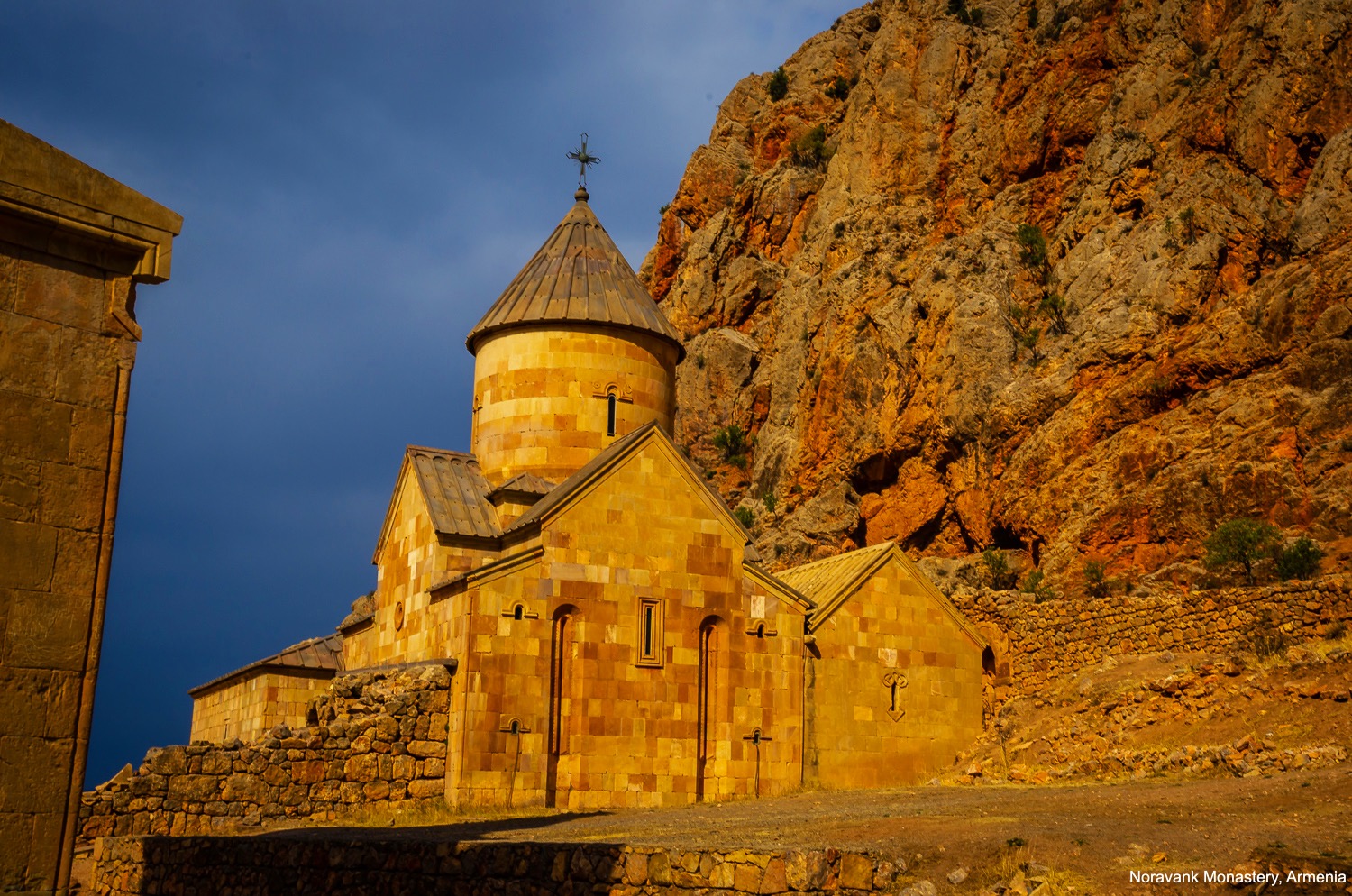Armenia is an incredible country. It’s small, smaller than the state of Maryland, smaller than Belgium, and even smaller than Taiwan. Yet it is full of attractions, from neolithic times to millennia-old monasteries to Soviet monuments. Every hour you drive through the country, you’ll find something interesting. But it’s not a relic of the past, it’s quite modern and the capital Yerevan abounds with museums, parks, restaurants, and pubs.
The Armenians are survivors and fighters. They have always lived in a tough neighborhood, scrunched between Russia, Turkey, and Iran. During WWI, the Ottomans forced them out of their ancestral land and hundreds of thousands were killed. Since the dissolution of the Soviet Union, it has been involved in many battles with Azerbaijan over the traditional Armenia area of Nagorno-Karabakh (aka Artsakh) in southwestern Azerbaijan. It was the first Christian nation and has remained so even after the spread of Islam and other religions around it.
Despite its turbulent past, uncertain present, and unknowable future, it’s a pleasure to drive through. The food is natural and served in huge quantities and there’s locally produced wine and legions of pubs. It’s about half mountainous and has hundreds of miles of hiking trails. Most importantly, there’s the Armenian hospitality which heartily welcomes visitors.
Where is Armenia?
Armenia is in the Caucasus, the land between the Black Sea and the Caspian Sea, also encompassing Azerbaijan, Georgia, and parts of Southern Russia.

To the North is Georgia, the east Azerbaijan, the south Iran the Azerbaijan exclave of Nakhchivan (Naxcivan), and west Turkey. This map is from ResearchGate.
Armenia is geographically in Asia but culturally is more European.
Why We Went to Armenia
My wife Khadija and I attended the first Extraordinary Travel Festival in Yerevan in October 2022. We used this as an opportunity to visit Armenia, Georgia, and Azerbaijan.
How Long to Spend in Armenia?
We spent a week touring the country and saw most of the main attractions. In two weeks, you certainly would see lesser-known ones and off-the-beaten-path interesting spots. If you like to hike, you could even spend longer.
However, some people love the vibe of the country and return repeatedly. My friend Gilberta has been there over 50 times!
What to Eat in Armenia
Armenian food is natural and, in our case, served in such quantities it was not humanly possible to eat all of it. A typical appetizer was a salad of tomatoes, carrots, and dates, highlighted by grated cheese, seeds, or grains.
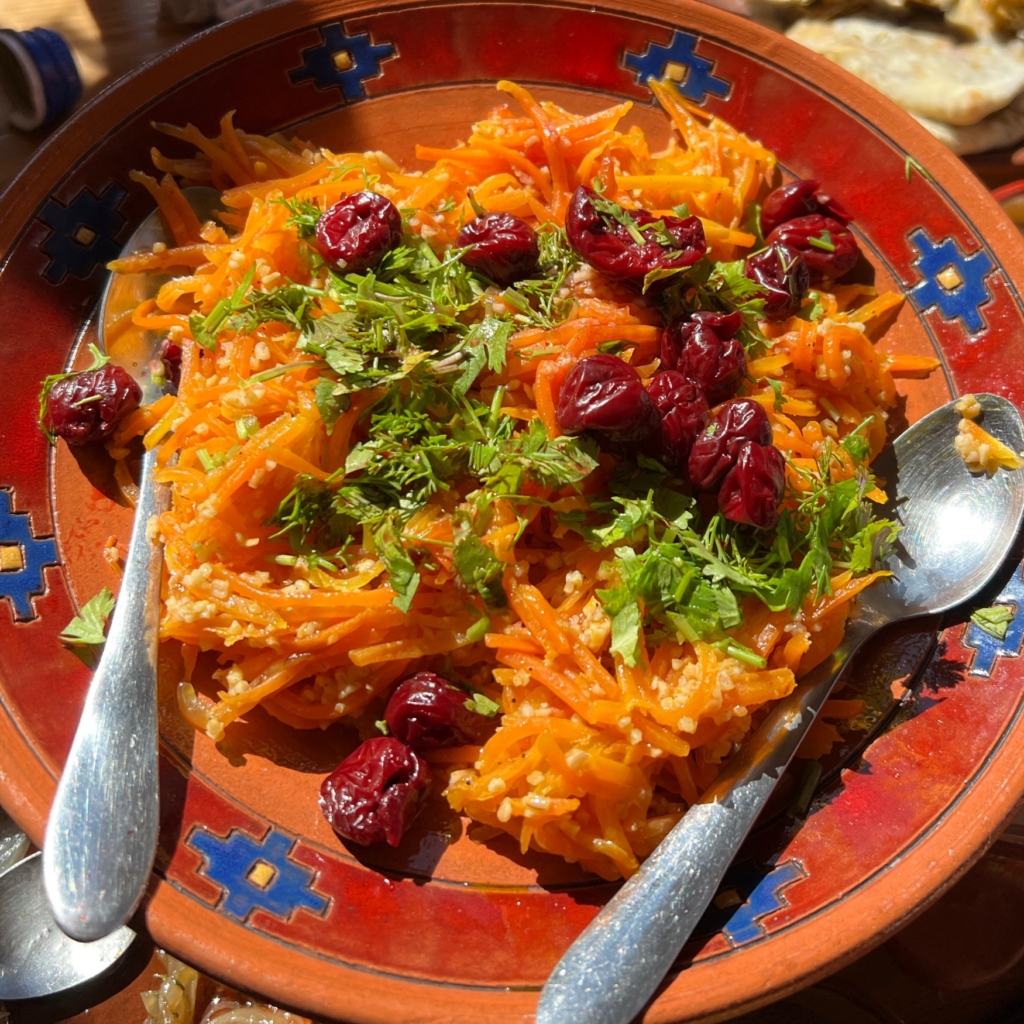
Almost always there is yogurt and olives. Often, lavash, a soft, paper-thin flatbread made of wheat flour and water, is served. The traditional way of making lavash is kneading the dough and heating it in a conical clay oven.
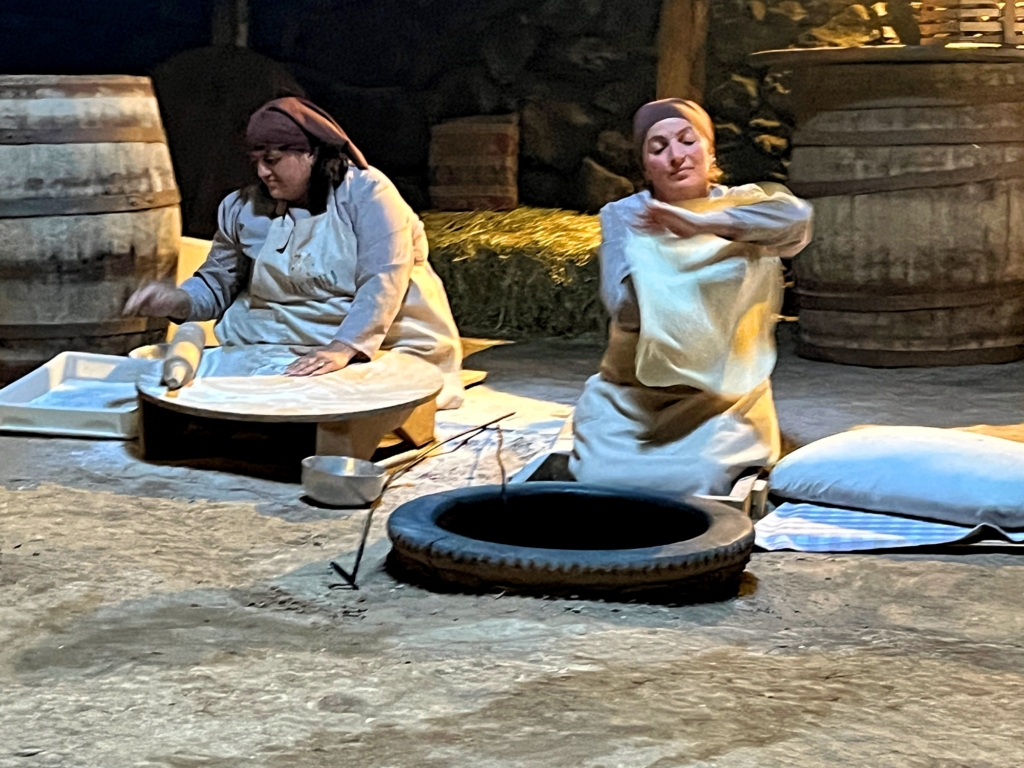
The main entrees are beef, pork, fish, mutton and goat.

In banquets or large groups, it’s common to have a mix of many meats and fish.
Is Armenia Safe?
Armenia has a reputation for safety and Yerevan is a particularly safe large city. However, as everywhere, be sure to exercise caution, especially in deserted places and late at night.
Is Armenia Expensive?
Armenia is relatively inexpensive compared to Europe and the USA. If you are a cost-conscious traveler but not a backpacker, you would probably spend at least $100/day on lodging, food, and transportation. With higher standards, it could be $150 / day or more.
Where to Stay in Armenia
We stayed in a combination of hotels and guesthouses, which were plentiful in most places we visited. In Yerevan, there are luxury hotels, as well as hostels. There are also many campsites scattered throughout the country.
How to get around Armenia
We infrequently take a group tour except for those offered by NomadMania which emphasizes unusual but interesting attractions. Eleven of us, including NomadMania’s founder Harry Mitsidis, took their one-week tour. Our group was composed of extreme travelers, some of whom we are now close friends. We took a group shot with Mt. Ararat (the site of the Noah Ark story) in the background, historically an Armenia area and now part of Turkey.
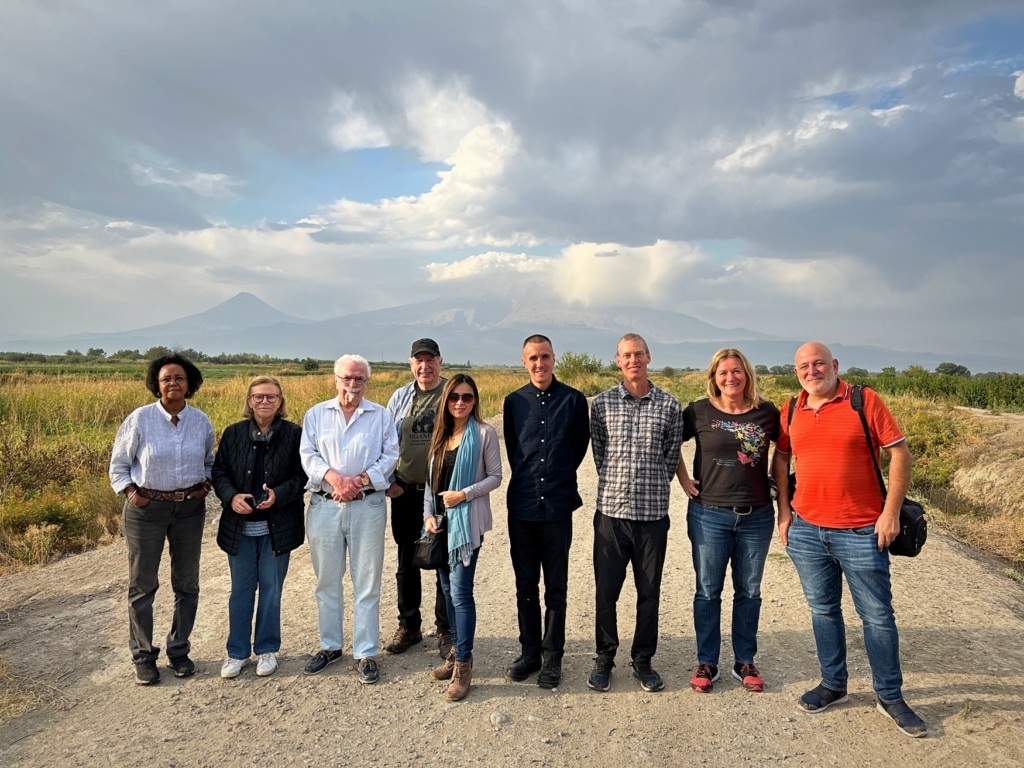
From left to right: Khadija, Erica (Harry’s mother), Bill, me, Lucy (been to all 193 United Nations countries), Ricky, Justin, Mette (visited all but one UN country), and Harry (one of the most traveled persons in the world).
Our tour traveled for six days through nine of the ten provinces in Armenia. The following map indicates the places we journeyed to by bus.

In Yerevan, taxis are cheap and Yandex (Russian) or GG (Armenian) apps are available. The subway is a definite option even though it has only ten stops on one line. In the clean and efficient trains, it’s a place to see the local population.

The engineering work of the subway tunnels was of such high quality that the Metro withstood the 1988 Armenian earthquake which paralyzed the whole nation.
Armenia Guides
Our excellent guide on our NomadMania tour was Shushanik (Shush) Kostandyan. She knows all parts of the country in detail. She is pictured below with Harry.
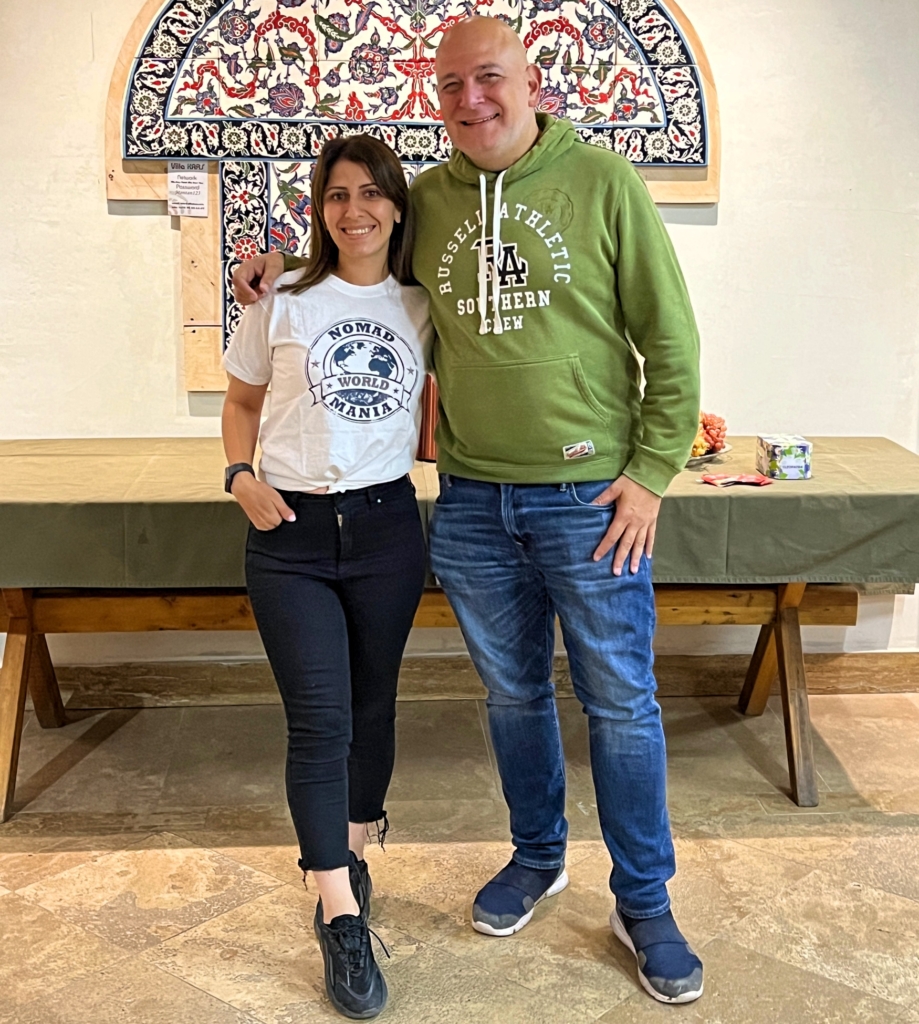
The tour was organized by Luisine Guin Dalera of Next is Armenia travel company.
For over ten years, Vako has been giving free walking tours in Armenia. We were impressed by his encyclopedic knowledge of the city.
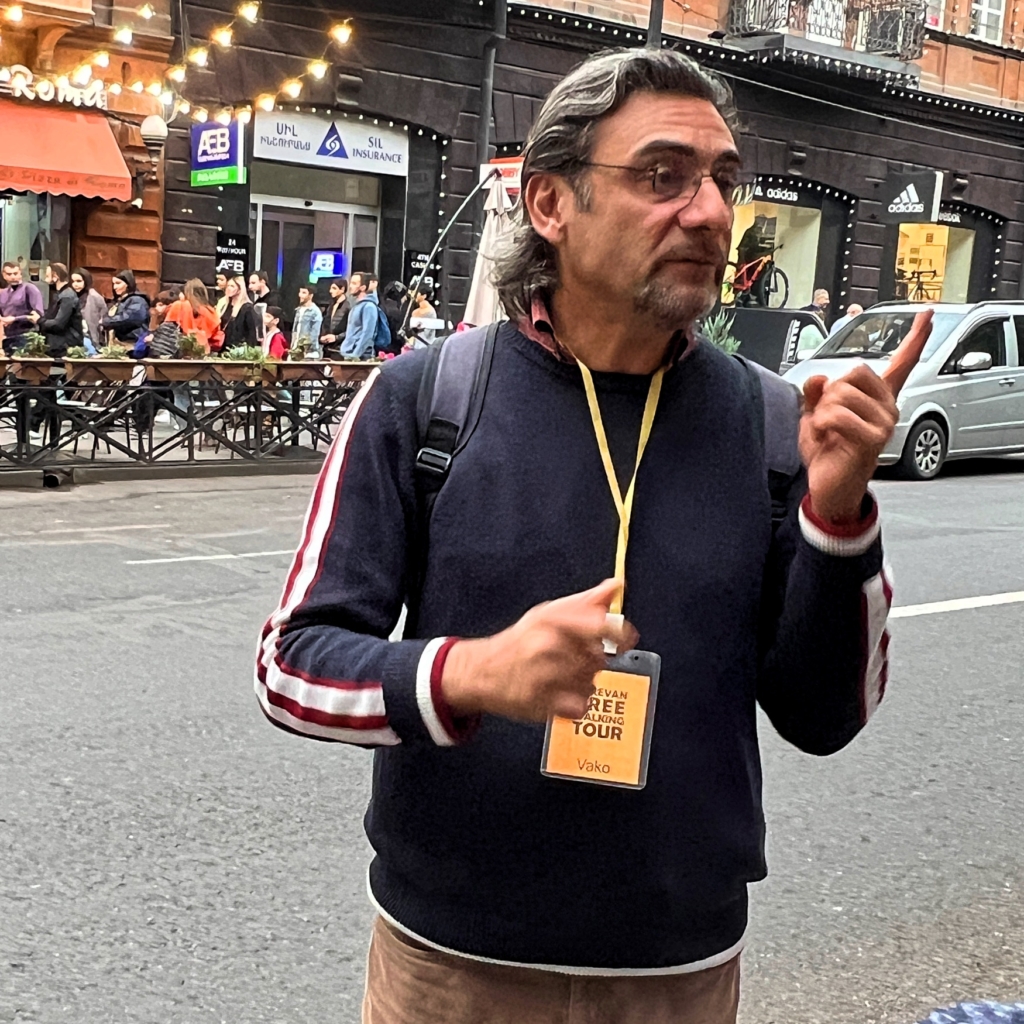
What Languages Are Spoken?
Not surprisingly, the official language is Armenian. It’s in the Indo-European family of languages and not closely related to any other one but has a few characteristics in common with Greek. The number of Armenian speakers worldwide is estimated between five and seven million.
The second most spoken language is Russian, as it was part of the Soviet Union. English is spoken widely enough that using it is easy enough to travel with.
As well as being part of the alphabet, all the original 36 letters also have an assigned numerical value based on their order in the alphabet. When arranged in four columns and nine rows, the letters in each column respectively represent digits in singles, tens, hundreds, and thousands.
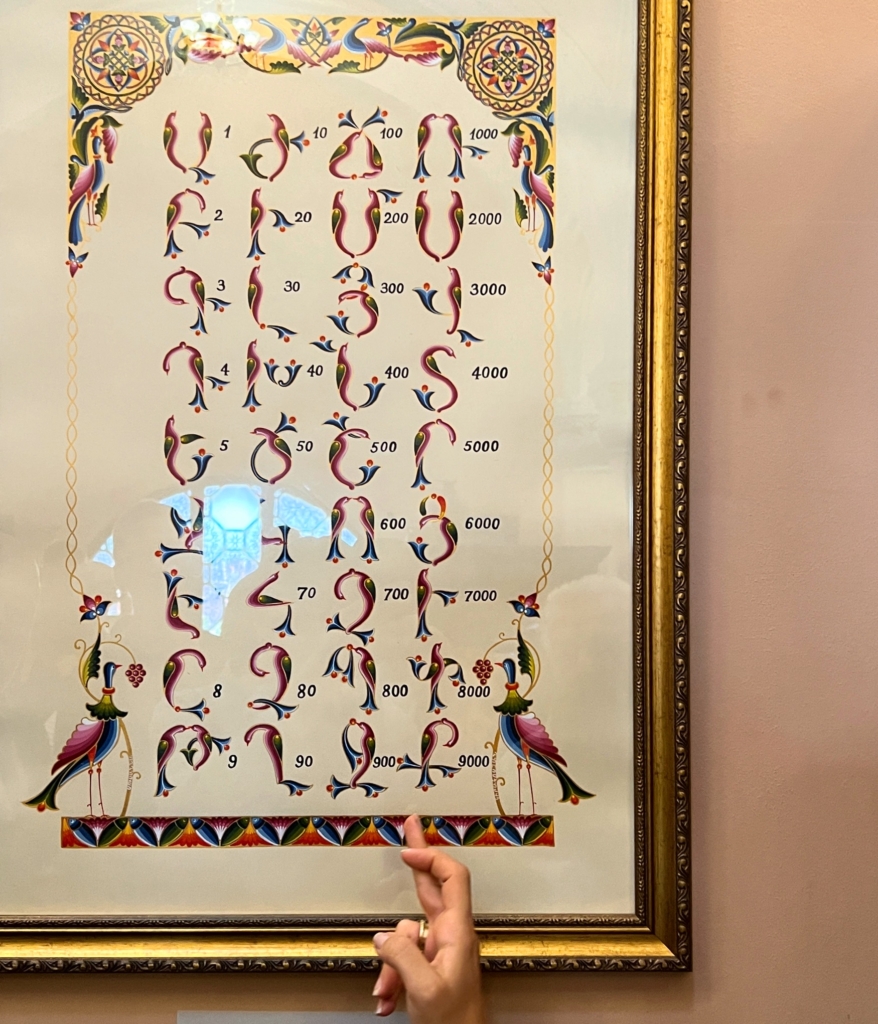
The modern alphabet has added three more characters for a total of 39.
Yerevan
Yerevan is one of the oldest cities in the world, more than 6,000 years old, and the largest city and capital of Armenia with a population of about one million. It’s the center of Armenian culture, estimated to be three million in the country and five million in the diaspora, a majority in Russia, the United States, and France.
The Cascade
The Cascade is a travertine-limestone stairway connecting buildings, parks, and fountains. It was built in 1971 and faces Mount Ararat. There are many statues including ones by international artists such as Lynn Chadwick and Francisco Botero, Mother Armenia at the top on a high pedestal, and of important Armenians such as Alexander Tamanian.

Tamanian was an architect and urban planner who was instrumental in transforming Yerevan from a small provincial city into the modern Armenian capital.
Admiring the complex from top to bottom can easily take an hour and has the added benefit of exercising the body by walking hundreds of steps.
Matenadaran
The Matenadaran has one of the largest manuscript collections in the world. The name is a combination of book and repository and there are other Armenian ones outside of Yerevan. The archive contains over 17,000 manuscripts of which over 14,000 are in Armenian.
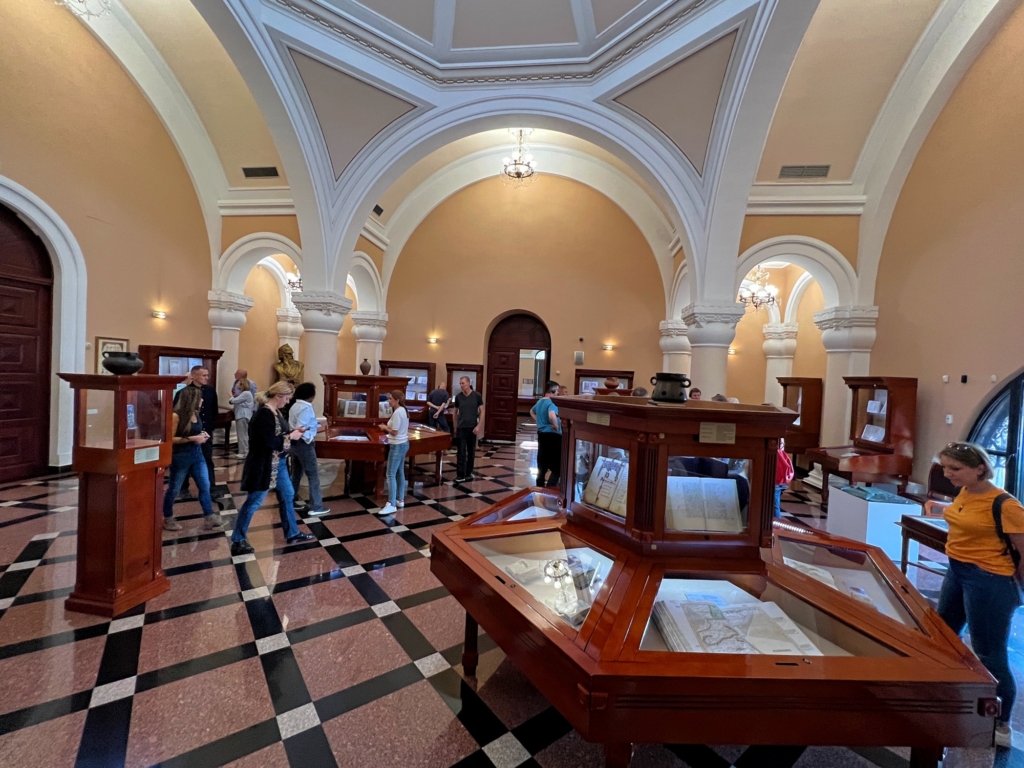
Some are wonderfully illuminated and a major part of the display to the public.
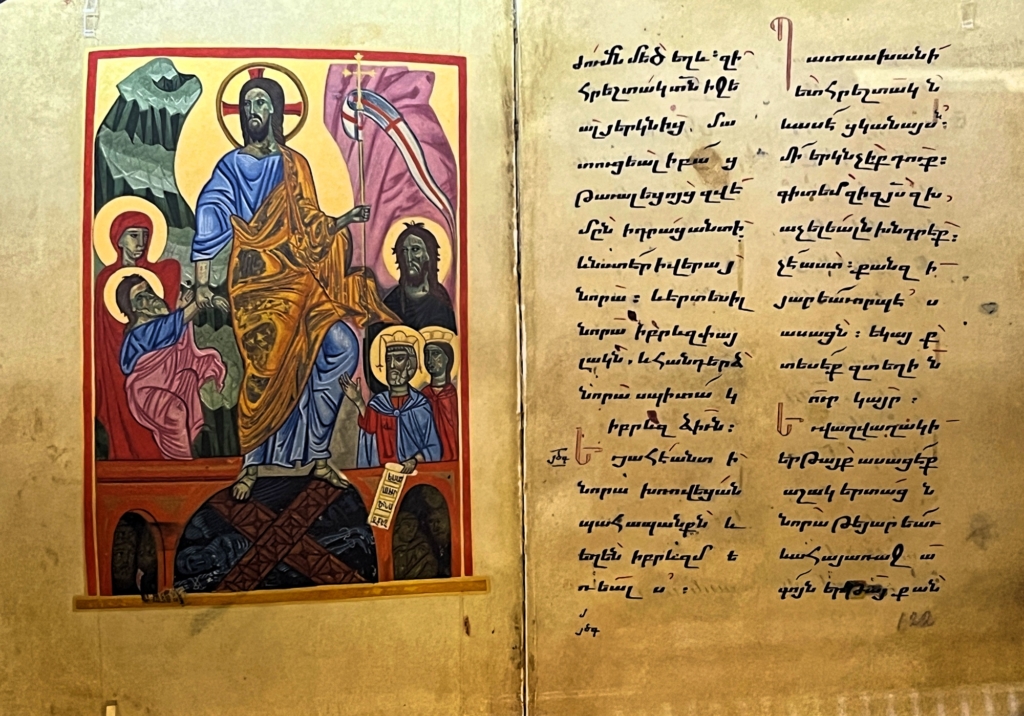
There’s also a restoration department that painstakingly works on important manuscripts.
Republic Square
Republic Square is the most important intersection in Yerevan consisting of five buildings built in pink and yellow tuff (solidified rock from volcanic ash, found in multiple colors across Armenia, a seismic zone).
In the following photo is the Government Building for the Prime Minister and other ministers in the parliamentary government. Stylistically, it combines a neoclassical framework with Armenian motifs and was originally designed by Alexander Tamanian in 1924 and the last building was completed in 1977. It’s an excellent example that not all Soviet architecture is drab and massive concrete blocks.
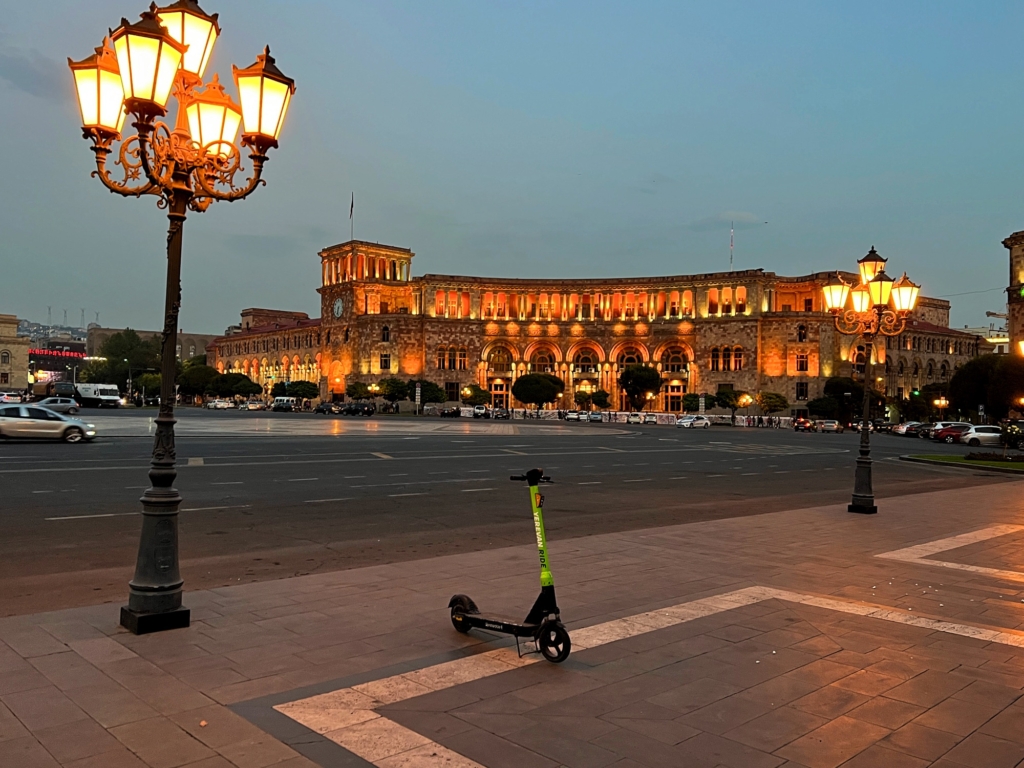
We were not able to visit the Museum Building with the History Museum and the National Gallery. It will be the first thing on our to-do list the next time we visit.
During the Soviet period, it was called Lenin Square with his statue in the middle. After Armenia’s independence in 1991, the square was renamed and the statue was removed. As the most frequently used space for protests and political speeches, it was the main site of demonstrations during the 2018 Velvet Revolution (so named as it was bloodless).
Water Fountains
What stood out to me were the numerous parks and squares in Yerevan with delightful water fountains.
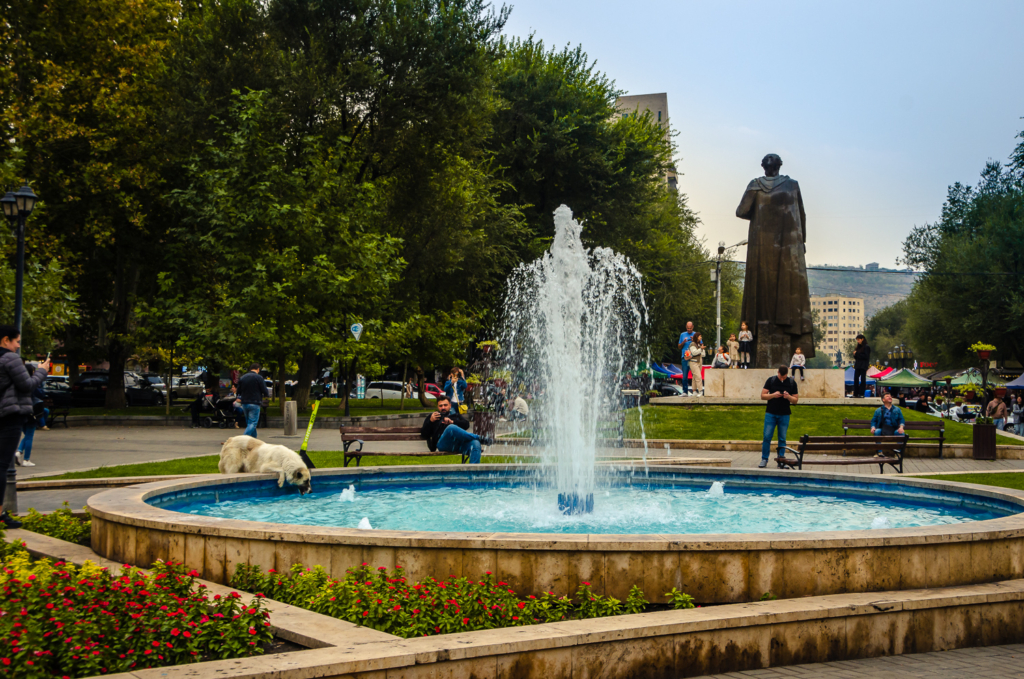
Underground Pubs
Yerevan is a dream place for pub crawlers with many underground (literally a few steps down from the sidewalk). During the Extraordinary Travel Festival, we visited many of them with other extreme travelers, many who were heavy-duty partiers.
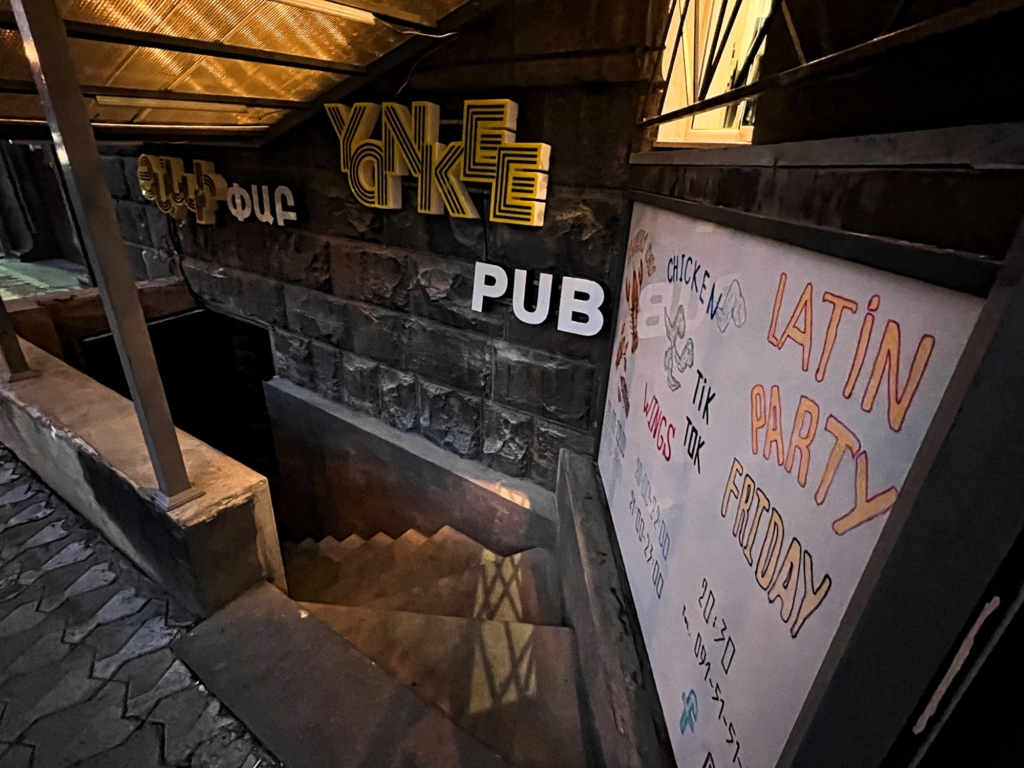
Northern Avenue
Northern Avenue is a pedestrian mall with one luxury boutique shop after another. There are escalators to the underground Tashir Street Shopping Galleries teeming with cafés, restaurants, and stores.

Swan Lake
In 2015, Kim Kardashian, who is of Armenian descent, and her then-husband Kanye West visited Armenia. Kanye decided to give an impromptu free concert by Swan Lake, which is behind the Opera House (designed by, you guessed it, Alexander Tamanian). For whatever reason, he decided to jump into the lake and dozens of the audience followed. The police then intervened to calm down the chaos and end the concert.
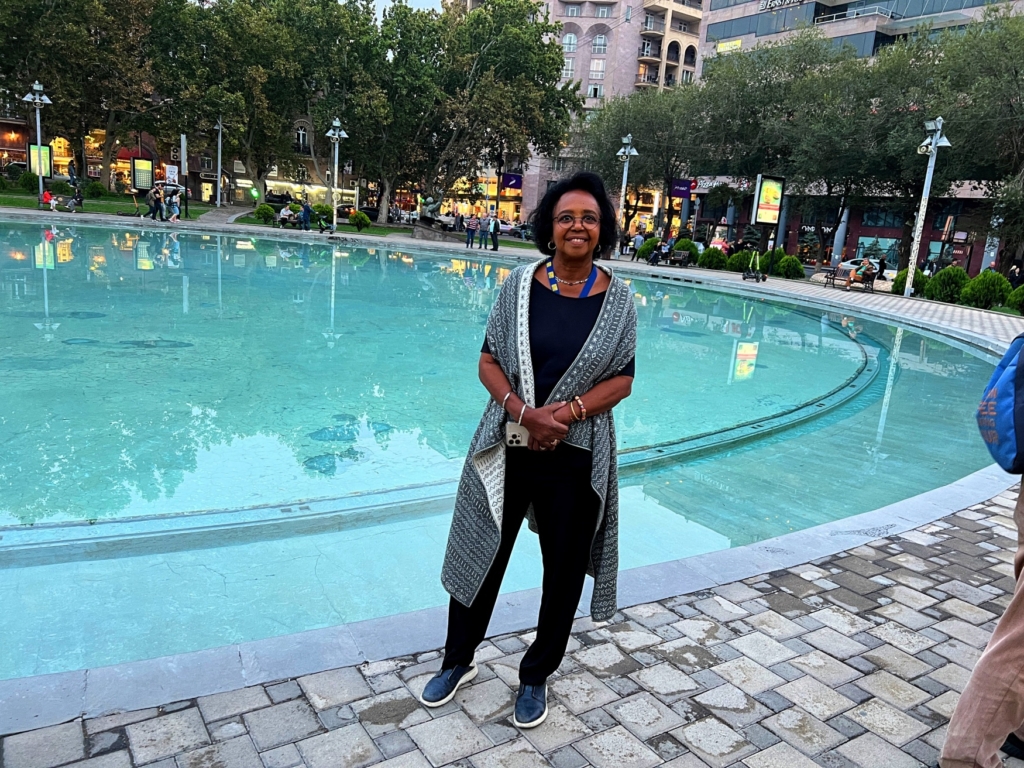
Other Attractions
We went to the Megerian carpet factory, where women were weaving on huge looms and displays with classic Armenia designs.
We also enjoyed our visit to the Ararat Brandy factory, a distiller for a popular cognac.
Geghard Monastery
The Geghard Monastery is a UNESCO World Heritage Site and was named after the spear used to wound Jesus during the Crucifixion. The church was initially carved from the beautiful high cliffs in the 4th century. In 1215, the pictured main church was built.
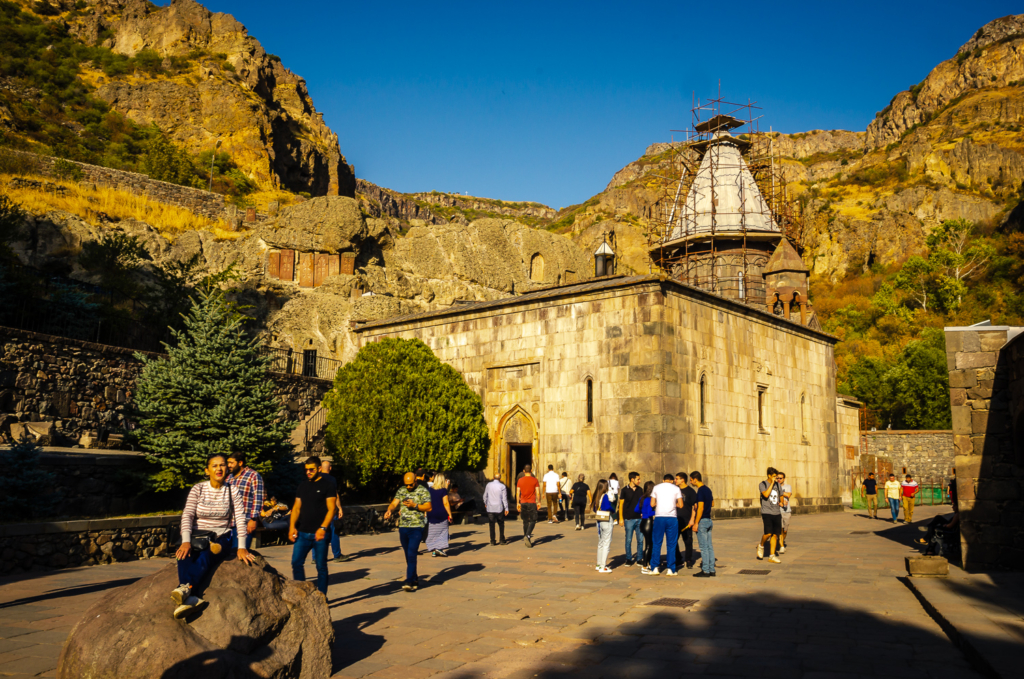
We were fortunate to be there when these singers performed.
As you see in the video, the Armenian Apostolic Church has austere decorations and avoids icons, usually having only a few images of Mary and baby Jesus.
Temple of Garni
The Temple of Garni is a fascinating structure of pre-Christian Armenia. It was built around the first century as a temple dedicated to Mithra, the god of light, a branch of Zoroastrianism prevalent in the Roman Empire before the acceptance of Christianity in the fourth century.
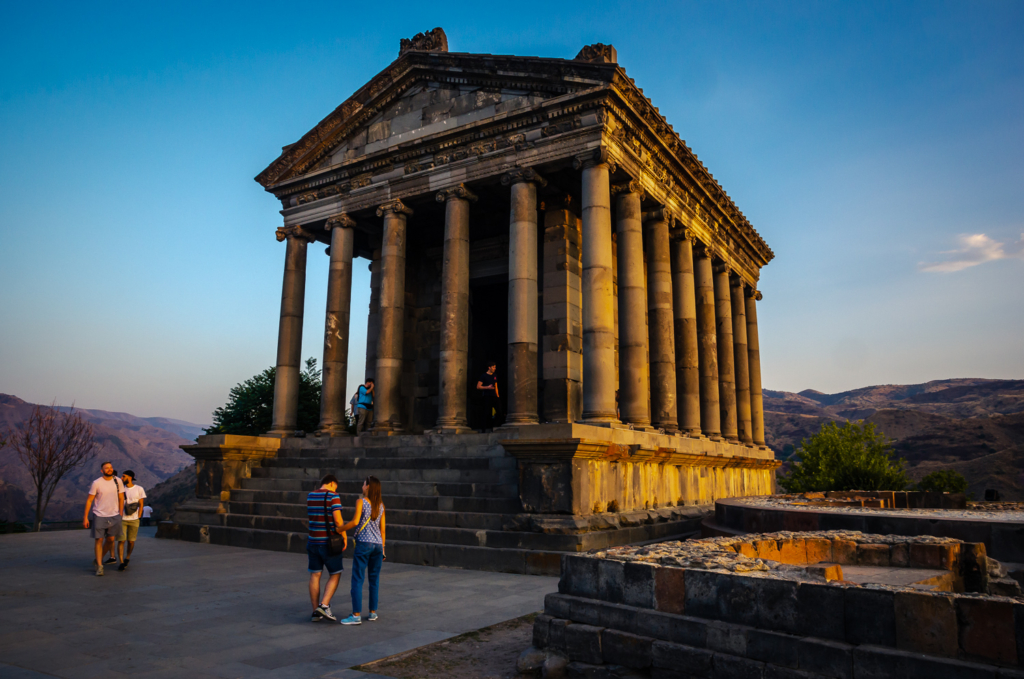
It collapsed in a 1679 earthquake and was rebuilt between 1969 and 1975. The temple is the only standing Greco-Roman colonnaded building in Armenia and the former Soviet Union.
Orgov Radio-Optical Telescope
The Orgov Radio-Optical Telescope is also known as ROT54. It was built between 1975-1985 and was active between 1986-1990 before it was decommissioned. In 1964, Armenian scientist Paris Herouni proposed the concept to Soviet authorities. In 1986, he was awarded the USSR State Prize.
It’s huge (54 m / 177 ft in diameter) and difficult to photograph all of it while on the rim.
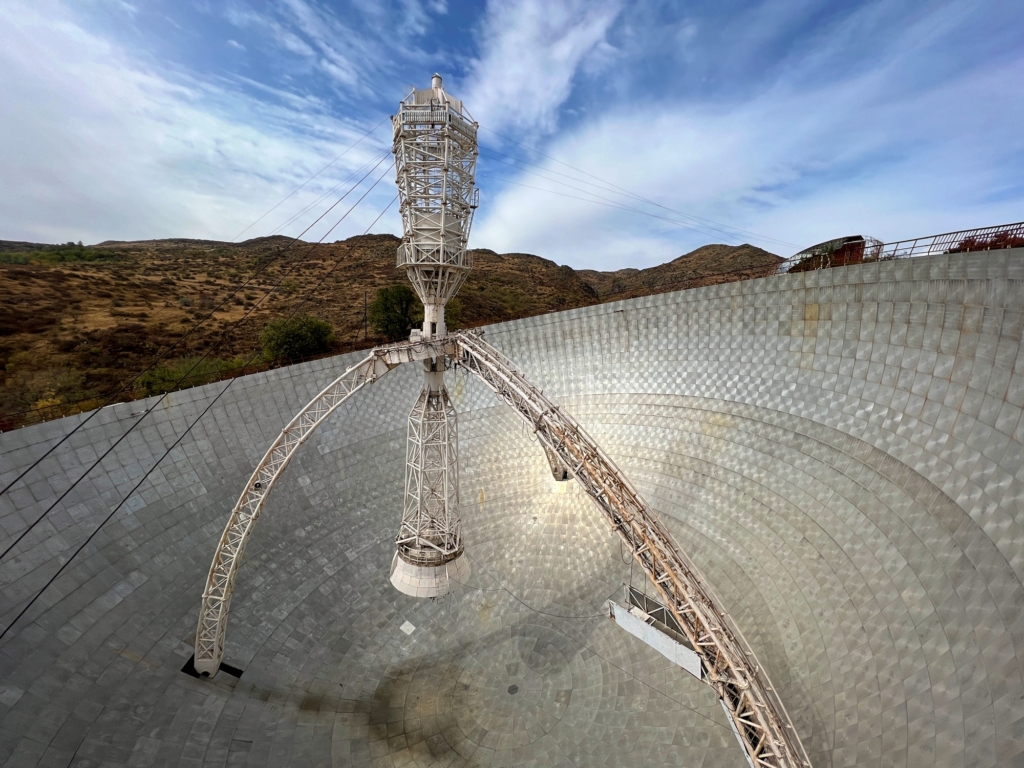
Reestablishing it would require replacing outdated analog equipment with digital control systems. While no longer in use, it has been a set for sci-fi movies and TV.
It’s best to get permission before arriving; see the website for the nearby Byurakan Observatory for more information.
Gyumri
Gyumri is Armenia’s second biggest city and a cultural hub. While the center area has many cobblestone streets and attractive plazas, there are quite a few buildings that haven’t been completely repaired from the 1988 earthquake.
Armenia is full of Soviet monuments. Many are war memorials, but they can be of anything noteworthy in the Soviet era including this one in Gyumri commemorating satellite technology.
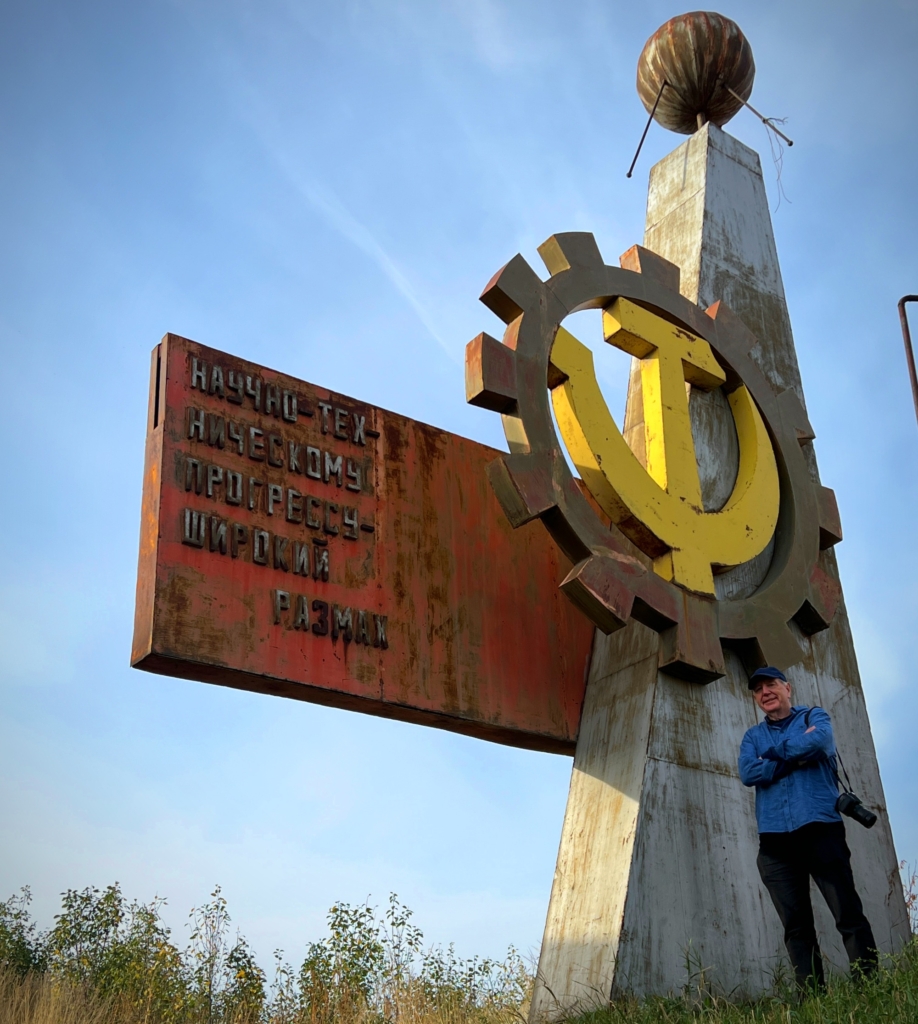
The city has many artistic flourishes on the street, as these wooden figures can attest.

We went to the Cobweb Art Gallery and met the proprietor artist, Andranik Avetisyan. One day he noticed a cobweb and wanted to use them in a picture. Then he began to study the life of spiders and the structure of their cobwebs. Afterwards, he began to breed spiders to use their cobwebs in pictures. His works are evocative and somewhat abstract. He was awarded the “New Talent and Creative Thought” prize at the Cannes International Exhibition of Modern Art in 2017.
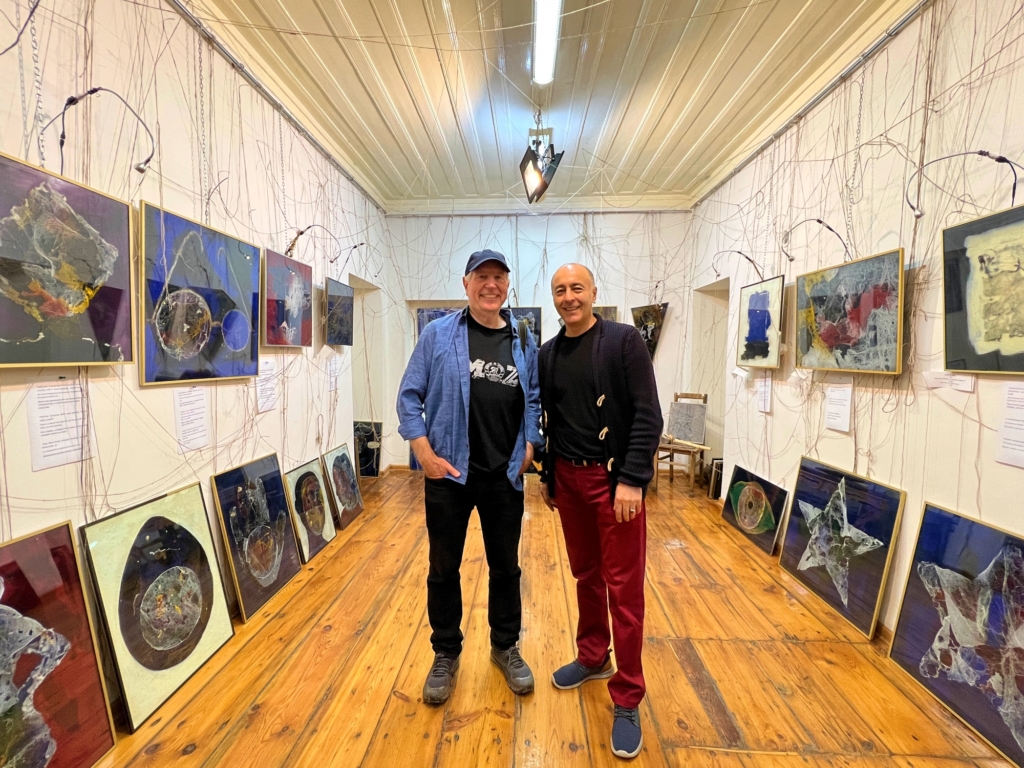
Also, check out the Art Basement 612 with works from several artists in different media.
Matosavank Monastery
All that’s left of the small, 13th-century Matosavank Monastery are ruins covered by the forest. Of particular interest are the rough-hewn stones and the dome.

This visit was the inspiration for Harry to write the farcical, comedy-thriller “Welcome to the Hotel NomadMania”. It’s in the spirit of Agatha Christie and extends over twenty global locations. The characters are real extreme travelers including Lucy, Mette, and Ricky who were on this tour. It starts with Lucy’s body being found in this monastery after falling (or being pushed) through the dome.
Vanadzor
Vanadzor is Armenia’s third largest city and has several places to see, including archaeological sites, a fine art museum, and a panoply of theaters. The highlight for me was the Soviet-constructed train station. On one interior wall, there’s a map in Cyrillic of the main train routes in the USSR. The capitals of the Soviet Republics are denoted with stars.

Dilijan
There are many monuments and graves for Armenian soldiers who died in wars with Azerbaijan or in WWII. Somewhere between 300,000 to 500,000 Armenians served with the Soviet forces between 1941 and 1945, and as many as half of them were killed or were missing in action.

Armenia, like other former and current Soviet states, often has etched pictures of the deceased on gravestones. I first thought these two graves were for brothers, but then I realized it was for a father and son.
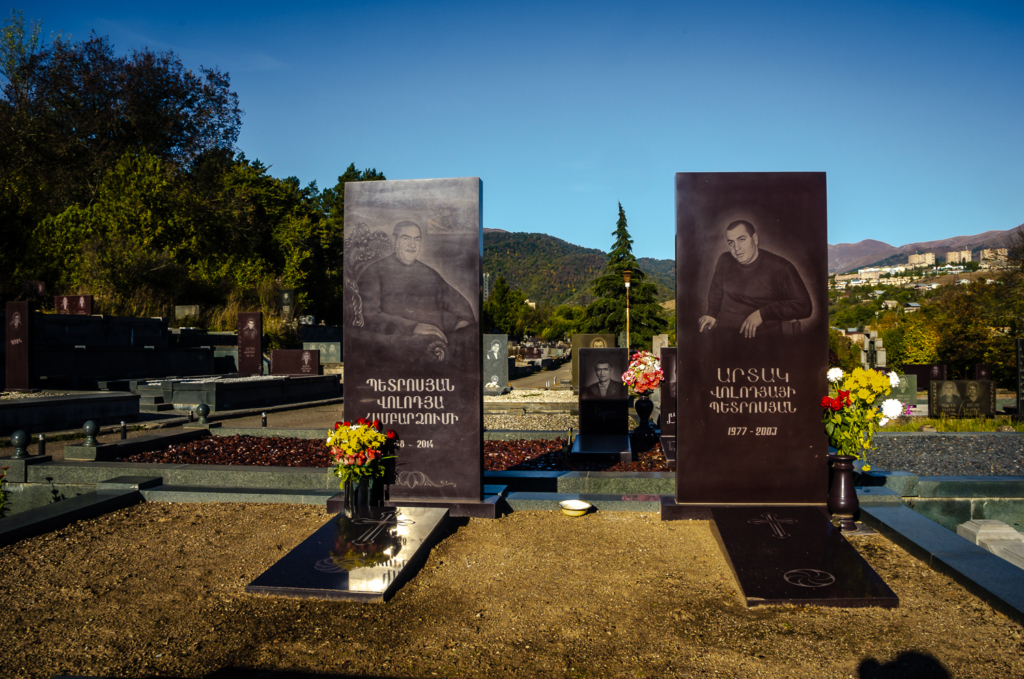
Noratus Cemetery
Noratus cemetery has the most khachkars (i.e. cross-stones) grave memorials in Armenia. They resemble Celtic crosses which makes you wonder if there had been some connection between Armenia and Ireland in the early centuries of Christianity.
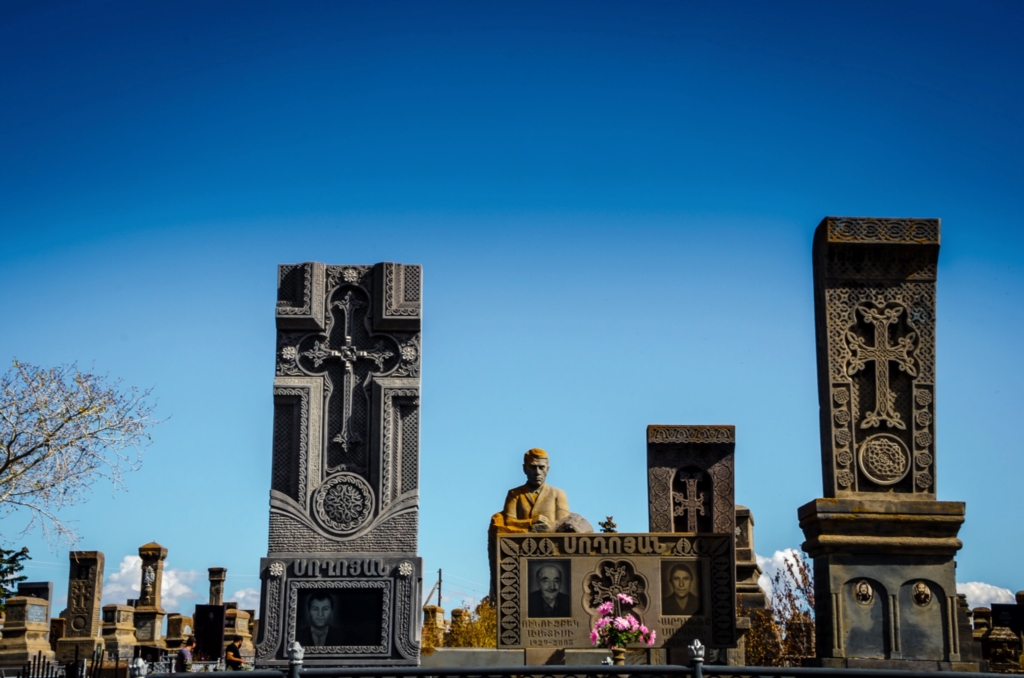
The oldest khachkars in the cemetery date back to the late 10th century. There was a revival for them in the 16-17th centuries. Today few are made because only a handful of stone cutters can sculpt them.
Formerly the largest cemetery with khachkars was in Nakhichevan (exclave of Azerbaijan) where perhaps 8,000 were destroyed by the Azerbaijani government. These types of actions inevitably happen during times of war and conflict, to the detriment of cultural patrimony.
Southwest Borders
Khadija, Mette, and Lucy are standing by a deteriorating monument close to the border of Turkey and Nakhchivan and not so far from Iran.
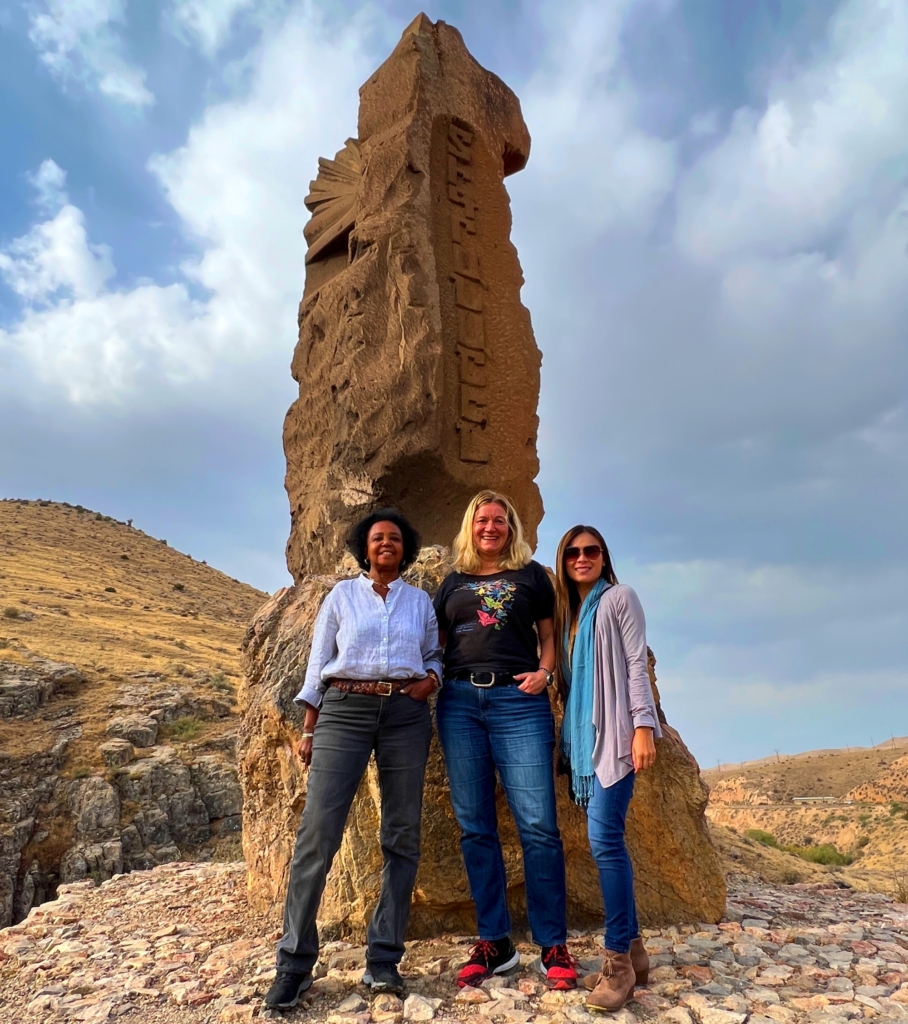
Nakhchivan is an Azerbaijan exclave between Iran, Turkey and Armenia. An exclave is a detached area of a country surrounded by other countries (e.g. Russia’s Kaliningrad is between Poland and Lithuania). When I first learned about them, I thought it was unusual, but I later researched and found there are many throughout the world.
Orbelian Caravanserai
Orbelian Caravanserai (a hotel on the Silk Road) was built in 1332 for travelers and their animals as they crossed over the Vardenyats Mountain Pass at a height of 2,400 m / 7,900 ft above sea level. It was built with blocks of basalt into a single hall in 1332, by prince Chesar Orbelian. The entry has decorations around the lintel, with reliefs of a winged animal to the left, and a bull to the right.
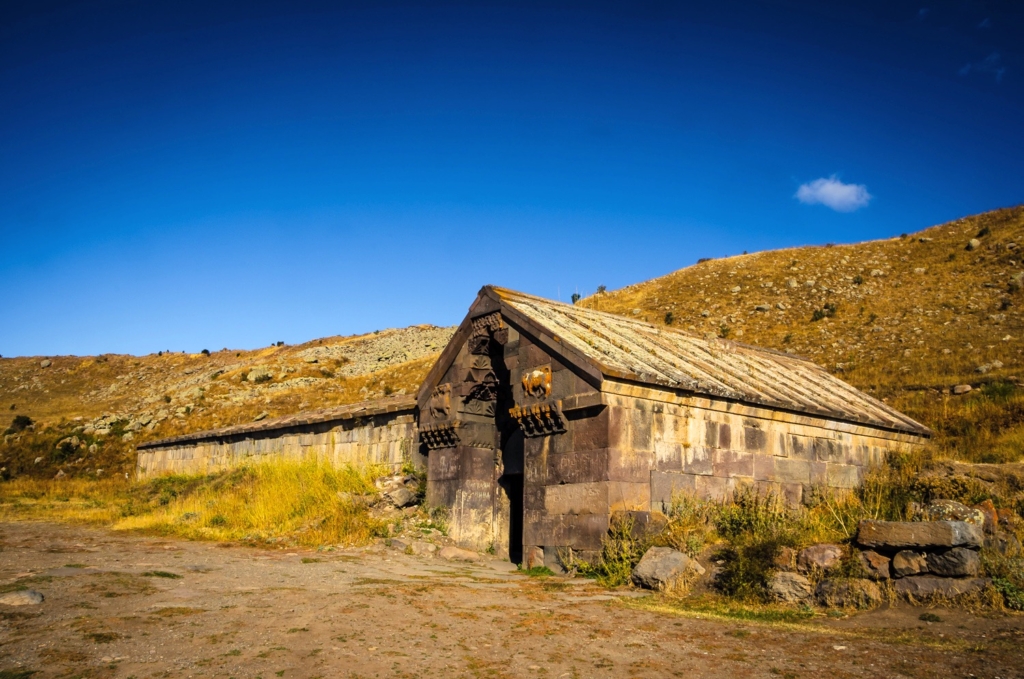
There are two inscriptions found on the walls of the vestibule, one is written in Persian and the other is written in Armenian. The Persian inscription has nearly been wiped out, but the Armenian inscription is legible.
Areni-1 Winery
Areni-1 is a 6,100-year-old winery discovered in 2007 in a cave complex in the village of Areni. Some believe it’s the oldest winery ever found in the world.
The winery consists of fermentation vats, a wine press, storage jars, and pottery sherds. The floor holes may have been used for storage of clay pots used for the fermentation process.

The artifacts have been removed to study and preserve.
Noravank Monastery
Noravank (New Monastery) is a 13th-century Armenian monastery, located 122 km / 75 mi from Yerevan. It’s perched on a hilltop in a deep gorge and made of limestone from a local quarry.
The complex has two large churches, St. John the Baptist (in the photo below) and the Holy Mother of God.
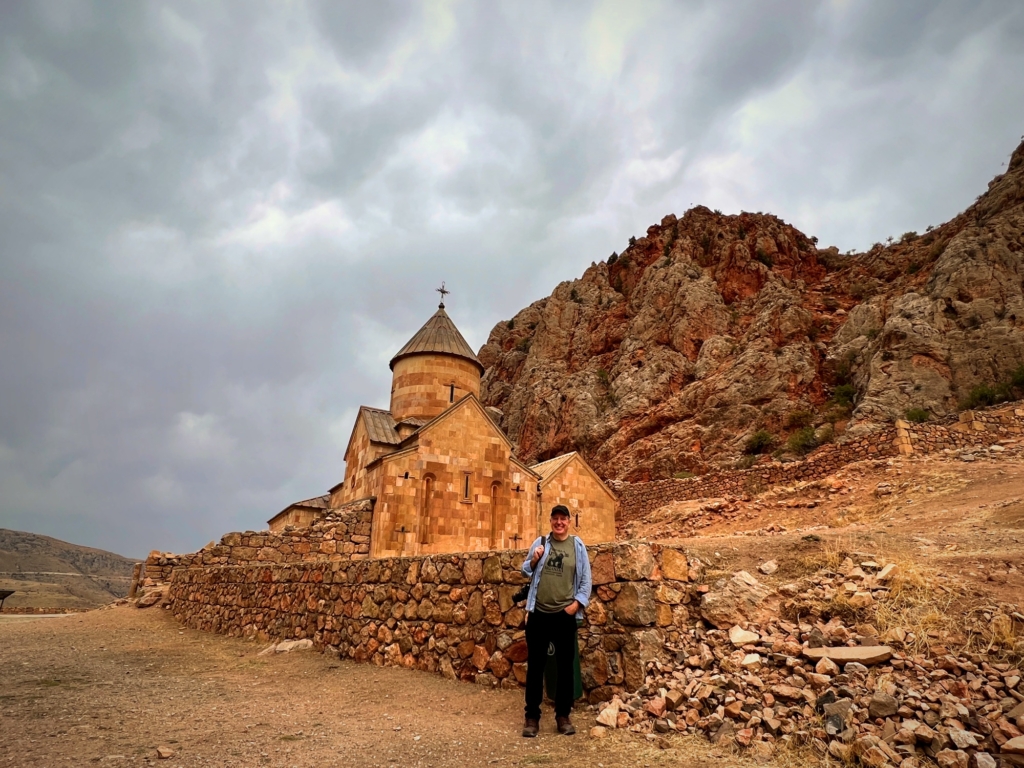
Shaki Waterfall
The Shaki Waterfall is situated 6 km / 3.5 mi from the town of Sisian, close to the Azerbaijan border. On a gorge, there’s a basalt ledge 18 m / 55 ft high from which the water flows over.
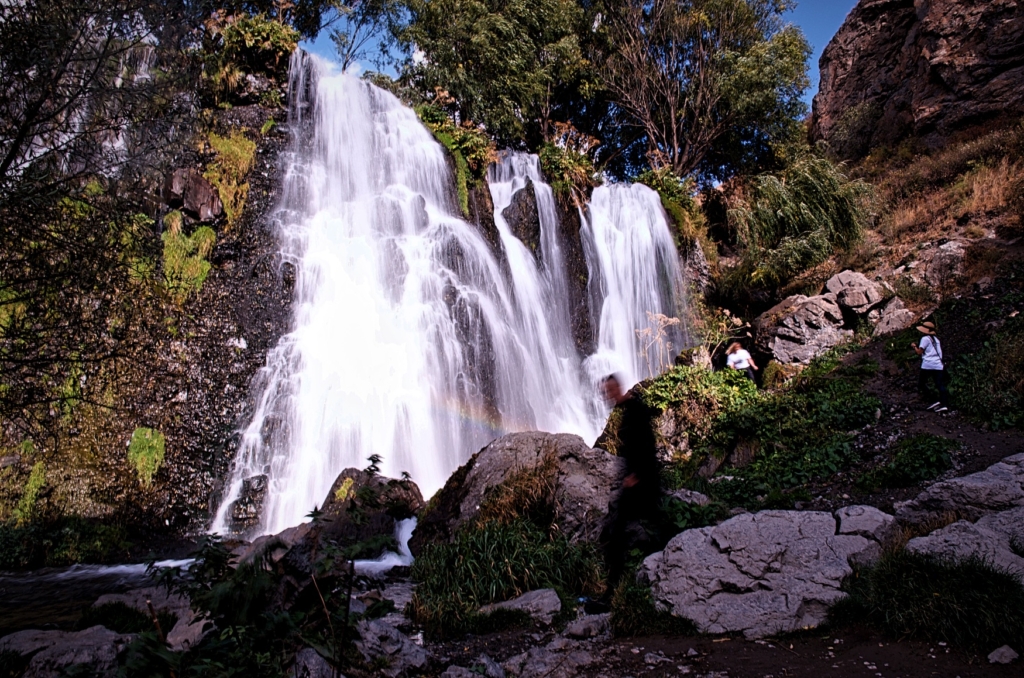
Later I learned that it doesn’t cascade 24/7 but is controlled and often is nothing but a trickle.
The nearby Sisian airport no longer operates for civilian aviation and is the site of a joint Russian-Armenian military post. We saw Russian soldiers up close who were there to maintain the tenuous peace between Armenia and Azerbaijan. Since the Russian invasion of Ukraine, which happened after we left, the Russian presence has notably decreased.
Goris
In Goris, we saw a small replica of the Eiffel Tower.

It’s the last stop on the route to Nagorno-Karabakh (aka the Republic of Artsakh), an Armenian enclave in Azerbaijan where several wars and skirmishes have occurred in the last three decades.
Don’t confuse this city with Gori in Georgia where Stalin was born.
Tatev Monastery
The stone monastery stands on the edge of a deep gorge made by the Vorotan River. It’s easily accessible by a 12-minute ride in the Wings of Tatev cable car.
The cable car passes over Vorotan Gorge where a switchback road climbs the steep mountain.
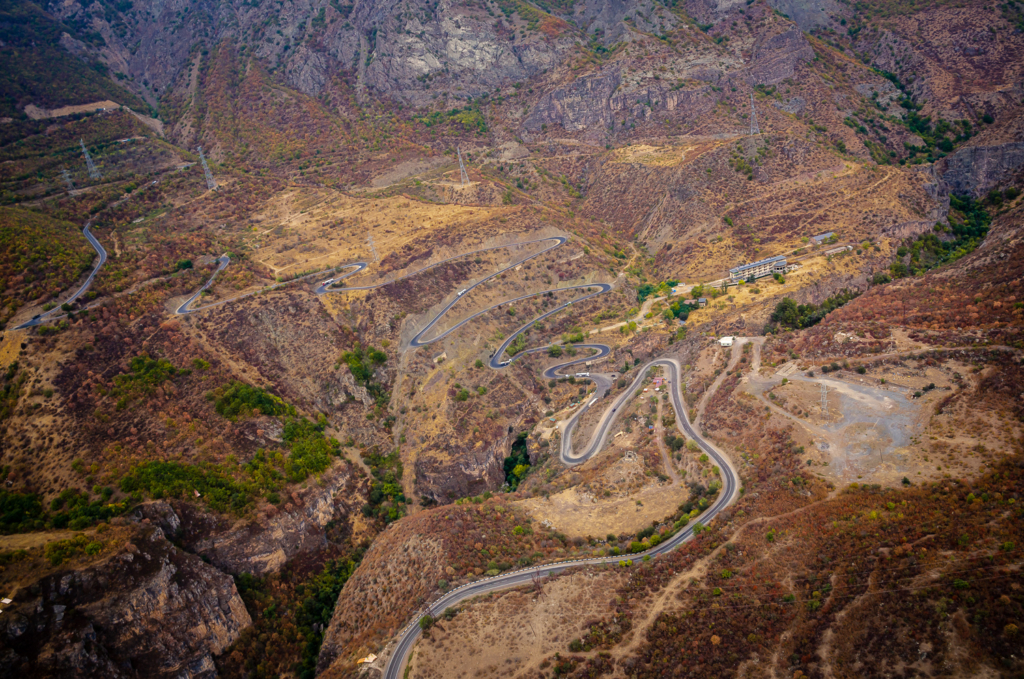
The grand monastic complex is located on a large plateau. It was built in 895 and includes three churches, as well as a mausoleum and other historical buildings.
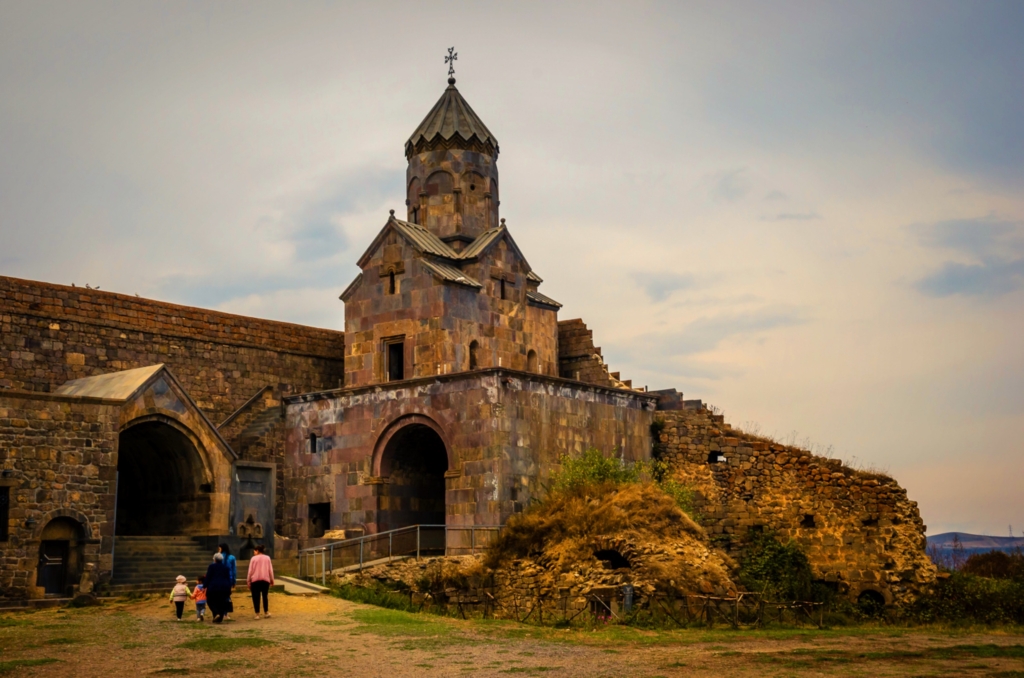
Armenian Christianity is part of the Oriental Orthodox tradition, but it’s actually Apostolic, meaning church doctrine was initially taught by one of Christ’s apostles. According to tradition, the church originated in the missions of Apostles Bartholomew and Thaddeus of Edessa in the 1st century. The Ethiopian Church is also Apostolic.
Karahunj
Karahunj is known as the “Armenian Stonehenge”. It is an ancient observatory with holes in the stones that correspond to the positions of the stars in the sky and allow a viewer to make fairly accurate astronomical calculations. There are approximately 300 upright stones, estimated between 5,000 to 7,500 years old, and mostly in a long line. In one spot, the stones form a circle which Lucy is in.

Khndzoresk Cave Village
The Khndzoresk cave village is located on the steep slope of a gorge and is comprised of both natural and manmade caves. To walk there, we descended 420 steps and crossed the swinging bridge.

Some estimate that the population grew to as many as 15,000. People lived here until the 1950s when the government made them move.

Extraordinary Travel Festival
The first (and not last) three-day Extraordinary Travel Festival was held in Yerevan, Armenia. Khadija and I were part of the group of about 125 extreme travelers at the event which featured one amazing speaker after another. Below are the attendees who had been to all UN countries or all but one. Rick Gazarian (second row, last on the right) is the organizer of the ETF and the host of the popular podcast Counting Countries.
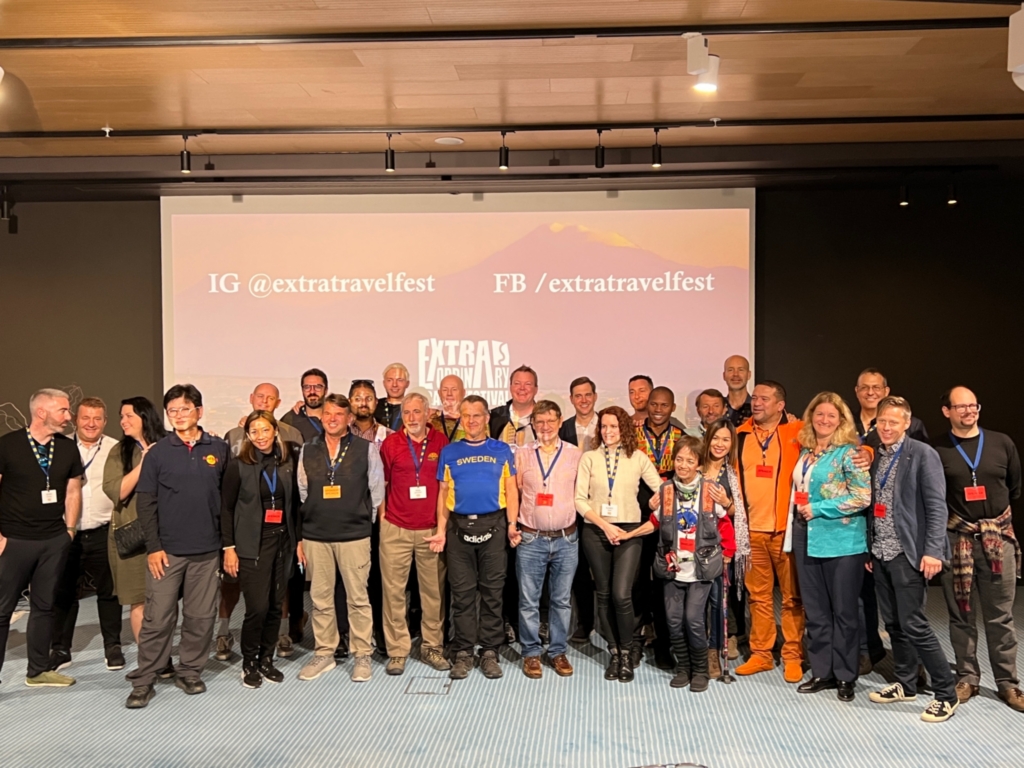
The next ETF will be in Bangkok, Thailand from November 15 – 17, 2024. Tickets are available here.
Final Thoughts
In Gyumri, our guide Shush organized a surprise 10-year birthday party celebration for NomadMania. In its first decade, the not-for-profit organization has connected with over 30,000 travelers. It divides the world into 1301 regions based on territory, population, diversity, economy, and tourist appeal. Members can use the site to see their progress on a variety of lists of locations.
NomadMania tours emphasize cultural sites and interesting lesser-known places and they accomplished this in our Armenia itinerary. While we saw an incredible amount of historic and cultural attractions in Armenia, we didn’t see them all. So, the next time we are in the Caucuses, we need to return here to further our explorations and soak up the warmth and energy of Armenia!

